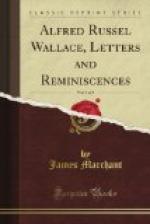I may perhaps push “protection” too far sometimes, for it is my hobby just now, but as the lion and the tiger are, I think, the only two non-arboreal cats, I think the tiger stripe agreeing so well with its usual habitat is at least a probable case.
I am rewriting my article on Birds’ Nests for the new Natural History Review.
I cannot tell you about the first appearance of tears, but it is very early—the first week or two, I think. I can see the Victoria Institute Magazine at the London Library.
I shall read your book, every word. I hear from Sir C. Lyell that you come out with a grand new theory at the end, which even the cautious (!) Huxley is afraid of! Sir C. said he could think of nothing else since he read it. I long to see it.
My address is Hurstpierpoint during the winter, and, when in town, 76-1/2 Westbourne Grove.
I suppose you will now be going on with your book on Sexual Selection and Man, by way of relaxation! It is a glorious subject, but will require delicate handling,—Yours very faithfully,
ALFRED R. WALLACE.
* * * * *
10 Duchess Street, W. February 7, 1868.
Dear Darwin,—I have to thank you for signing the Memorial as to the East London Museum, and also for your kindness in sending me a copy of your great book, which I have only just received. I shall take it down in the country with me next week, and enjoy every line at my leisure.
Allow me also to congratulate you on the splendid position obtained by your second son at Cambridge.
You will perhaps be glad to hear that I have been for some time hammering away at my Travels, but I fear I shall make a mess of it. I shall leave most of the Natural History generalisation, etc., for another work, as if I wait to incorporate all, I may wait for years.—Hoping you are quite well, believe me yours very faithfully,
ALFRED R. WALLACE.
* * * * *
Down, Bromley, Kent, S.E. February 22, [1868?].
My dear Wallace,—I am hard at work on sexual selection and am driven half mad by the number of collateral points which require investigation, such as the relative numbers of the two sexes, and especially on polygamy. Can you aid me with respect to birds which have strongly marked secondary sexual characters, such as birds of paradise, humming-birds, the rupicola or rock-thrush, or any other such cases? Many gallinaceous birds certainly are polygamous. I suppose that birds may be known not to be polygamous if they are seen during the whole breeding season to associate in pairs, or if the male incubates, or aids in feeding the young. Will you have the kindness to turn this in your mind? but it is a shame to trouble you now that, as I am heartily glad to hear, you are at work on your Malayan Travels. I am fearfully puzzled how far to extend your protective views with respect to the females in various classes. The more I work, the more important sexual selection apparently comes out.




